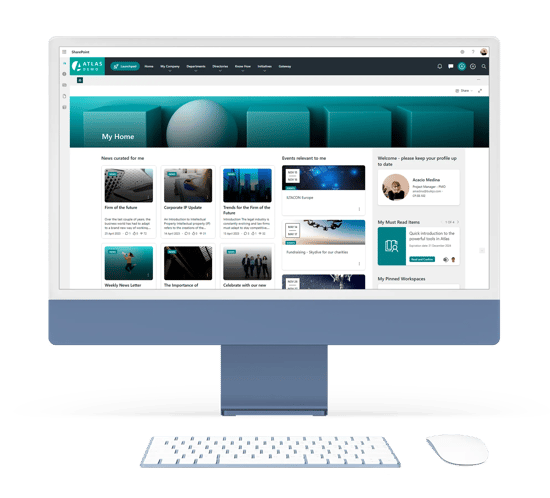The modern workplace is forcing companies to change the traditional workplace into more of a digital workplace.
So what is the difference then between a digital workplace and a digital workspace?
In this blog:
What is a digital workplace?
Let's start with what is a digital workplace? There are numerous definitions of the digital workplace.
Microsoft’s definition of a digital workplace is “The digital workplace encompasses all the technologies people use to get work done in today's workplace… It ranges from your HR applications and core business applications to e-mail, instant messaging and enterprise social media tools and virtual meeting tools.”
Read more in our blog: Is Microsoft the best digital workplace solution?
What is a digital workspace?
The digital workspace empowers employees to work across all of their devices and applications, regardless of where they are. Most definitions center around digital solutions that allow employees to work flexibly from anywhere and on any device.
Some argue that the digital workplace is a broader term and includes digital technology in the office such as digital signage, wayfinding apps on a smartphone or displayed on walls, temperature scanners, smart cameras, digital whiteboards etc.
What is the difference between Digital Workplace and Digital Workspace?
Both terms are often used interchangeably and so you could argue they are the same. There is only one minor difference (see point 1). However, we have added extra thoughts on why digital workplace is becoming more used as a term. These are the four differences between a digital workspace and a digital workplace:
1. Workplaces are fixed, workspaces are flexible
Workplace: It is in the name, a workplace is a place where you go to work. It is a space where you go to, to get work done, like your office, the lobby, a meeting pod, etc.
Workspace: A workspace is more related to a place where you do your work. This can be your desk, your room at the office, your home office or even when commuting and working on the train.
2. The digital workplace and workspace is the virtual version of the physical workspace
What is the digital workspace? Digital workplace or workspace technology is a collection of evolving technologies designed around user’s needs that will give them the space and freedom to work securely anywhere and on any device. It can be your laptop and mobile for example, but it also includes technologies such as an intranet, document and knowledge management systems, CRM, chat tools, email, and more. Through integrating, enhancing or developing this mix of systems, servers and apps in the cloud, the Digital Workspace is an employee experience evolution, designed for a mobile workforce.
Digital workspace has gained more favour with companies like Citrix, VM Ware etc.
Digital workplace is used by vendors like Microsoft, intranet providers and more.
3. The digital workspace turns aspirations into a reality
Being forced to work from home has not been easy for everyone. The pandemic has made many people aware of the importance of having the right tools in place in order to get their work done – away from the office. And having the tools is not enough. You may have multiple tools that you are used to when you were working at the office. But if you are not next to your co-worker, it may not be working as smoothly as before.
The digital workplace is defined as “the concept that businesses should use digital transformation to align technology, employees and business processes to improve operational efficiency and meet organisational goals.“
The ClearPeople definition of the digital workspace is not a concept but a proven solution (Atlas) that transforms productivity from aspiration to reality.
4. A digital workspace should be inclusive
For us, the digital workspace has a great impact on an organisation’s work culture by improving the way employees collaborate, communicate and share knowledge. The digital workspace therefore does more than help people with communication, knowledge, and collaboration - it promotes inclusivity. We created specific features to enable inclusivity and made accessibility one of the key pillars of the Atlas vision.
Benefits of the digital workplace
The digital workplace enables new, more effective ways of working, raises employee engagement and agility, employs consumer-oriented styles and technologies to deliver an employee experience that will help attract, engage and retain your people. Kkey benefits of a digital workplace include:
- Improve customer experience
Experience is more joined up across the business, leading to increased customer satisfaction and loyalty. In addition, customer knowledge stays within the organisation, even if the employee leaves.
- Boost productivity
A more productive work environment leads to less time spent answering repetitive questions and duplicating work.
- Enhance employee experience
More employees are choosing employers that offer flexible working and provide a more satisfying employee experience. A digital workspace facilitates flexible working and makes employees feel more engaged and satisfied.
- Innovative business strategy
Innovation and new ideas. Delivery of insights to propel and inform business decisions. Knowledge creation to fuel competitive advantage.
- Gain corporate memory
When an employee leaves, they take with them valuable knowledge about your company, current projects and history. A digital workplace platform helps businesses build, grow and retain their corporate memory.
- Reduce costs
The digital workplace is proven to reduce real-estate. According to Global Workplace Analytics, employers can save over $11,000
per half-year.
- Infrastructure consolidation
The savings for our clients have been considerable; from consolidating obsolete infrastructure, to reducing IT involvement in supporting legacy applications. Savings start at hundreds of thousands per year.
- Employee retention
The digital workplace contributes to a happy workforce. While it’s difficult to fully calculate the cost of turnover, industry experts often quote 25% of the average employee salary as a conservative estimate.
- Increase collaboration
The right tools allow employees to communicate and collaborate more effectively with the right people.
Challenges of the digital workplace
ClearPeople has been at the forefront of Microsoft 365 adoption for some years, which means working at the frontline, helping clients transition to the new world of work. Naturally, we've garnered a lot of feedback about what works, what's challenging and what's downright difficult! Some of the key challenges of the digital workplace include:
- Engagement
Improving employee engagement and productivity is hard - and even harden when working remotely.
- Adoption is slow
Organisations are unable to realise their investment in Microsoft 365 and unleash its full potential.
- Sprawl of data
Knowledge sharing is more difficult as we introduce new data silos and create end-user confusion.
- I can't find stuff
“Employees can spend 1.8 hours searching and gathering information per day.” – McKinsey
- Too many apps
“The average person has 60-90 apps. 69% of workers waste up to an hour per day navigating between apps.” - RingCentral
- Too many silos
Inefficient communication and substandard collaboration costs £8k /person p.a. according to Raconteur. And customerTHINK says just 2% of businesses feel they are effective at data sharing.
A digital workplace framework
Deloitte’s Digital Workplace Framework
Even though this framework is over ten years old, it has concepts that are relevant today. The digital workplace framework includes four layers covering the following components:
- Use: collaborate, communicate, connect
The digital workplace is all about the employees’ ability to do their job by collaborating, communicating and connecting with others. The goal is to forge productive business relationships within and beyond natural work groups and to enable knowledge sharing across the organisation.
- Technology: the digital toolbox
Technology enables the digital workplace. Each organisation already has a digital workplace toolbox with different tools. The key is to adopt the right tools for your employees to do their jobs.
- Control: governance, risk and compliance
The effective use of technology in the digital workplace is underpinned by appropriate controls. This means you must support the digital workplace with appropriate governance structures and management processes. Information flow and use must also comply with your organisation’s policies and industry regulations.
- Business drivers: measurable business value
As with any core initiative, it is essential for business needs to drive the digital workplace. To deliver the necessary benefits, the direction of your organisation should guide the direction of your digital workplace.
Read more in our blog: Digital Workplace Maturity Model
Summary
In summary, there are some very slight differences between digital workspace and digital workplace. Generally, both terms are used in the same context and may depend on one’s personal preference. At ClearPeople, we prefer to use the term digital workplace. We define the digital workplace as "a collection of digital technologies that optimises the employee experience and provides new and better ways of working.”
Do you want your digital workplace to be a success? Atlas is the digital workplace platform of choice.
Atlas: Best Digital Workplace platform
Built for Microsoft 365, Atlas Digital Workplace and Intranet platform enables better ways of working for the modern enterprise. With Atlas, your employees can find the knowledge, information and tools they need - in seconds - allowing them to focus on doing their best work.
Some of the world's most recognised medium and large organisations trust Atlas to solve today's working problems; surfacing content and knowledge, and removing silos that hinder collaboration.
|

|









